Dallas, TX Pollen and Allergy Report for Summer 2023
Pollen Allergy Trends in Dallas, TX
When is pollen lowest in Dallas, TX?

February
Lowest month total PPM
Avg. PPM
When is pollen highest in Dallas, TX?

March
Highest month total PPM
Avg. PPM
How does pollen in Dallas, TX compare to Texas?
Dallas has a higher average PPM than the state of Texas.
Dallas yearly avg PPM:
Texas yearly avg PPM:
How does pollen in Dallas, TX compare to the USA?
Dallas has a higher average PPM than the USA.
Dallas yearly avg PPM:
USA yearly avg PPM:
Is pollen worse this year in Dallas, TX?
Spring 2023 was worse than spring 2022.
Spring 2023 PPM:
Spring 2022 PPM:
Average PPM in Dallas, TX
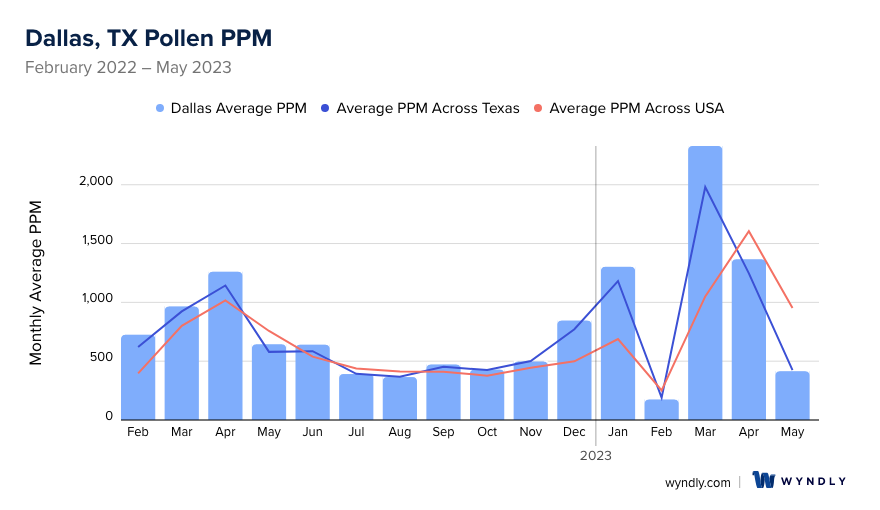
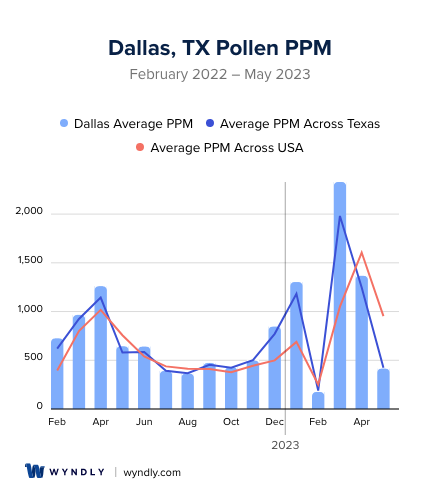
Dallas, TX Pollen and Allergy Breakdown by Month
Grass
When is grass pollen highest in Dallas, TX?
February has the highest grass pollen in Dallas, TX with an average PPM of
When is grass pollen lowest in Dallas, TX?
December has the lowest grass pollen in Dallas, TX with an average PPM of
Tree
When is tree pollen highest in Dallas, TX?
March has the highest tree pollen in Dallas, TX with an average PPM of
When is tree pollen lowest in Dallas, TX?
July has the lowest tree pollen in Dallas, TX with an average PPM of
Weed
When is weed pollen highest in Dallas, TX?
December has the highest weed pollen in Dallas, TX with an average PPM of
When is weed pollen lowest in Dallas, TX?
February has the lowest weed pollen in Dallas, TX with an average PPM of
Dallas, TX Pollen Monthly Breakdown by Pollen Type
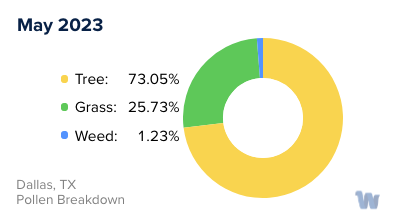
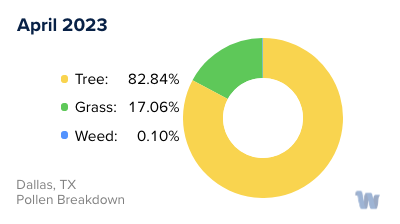
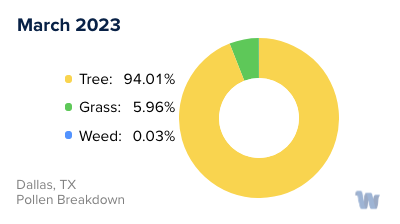
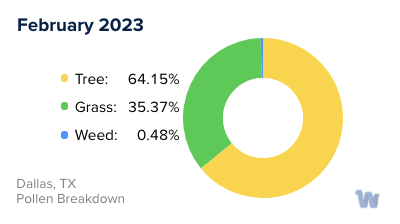
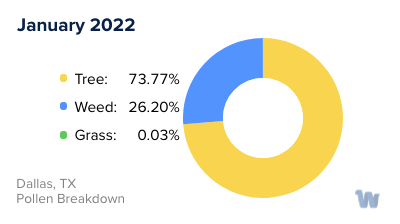
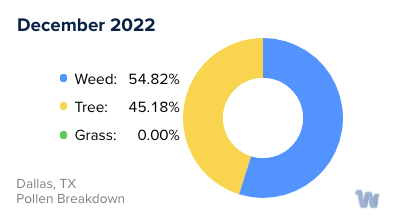
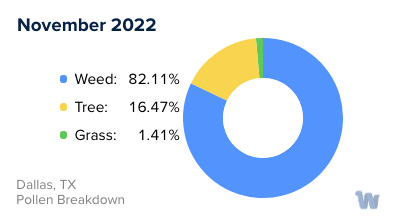
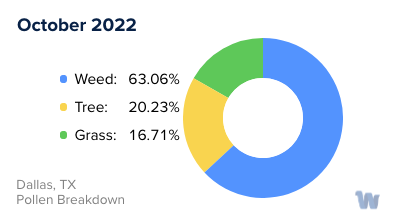
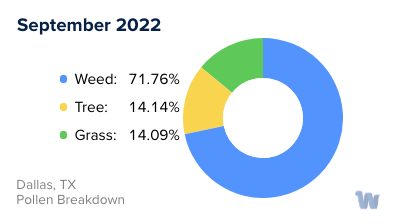
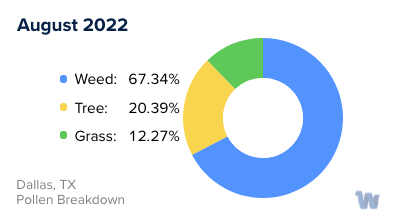
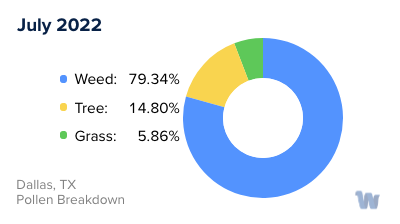
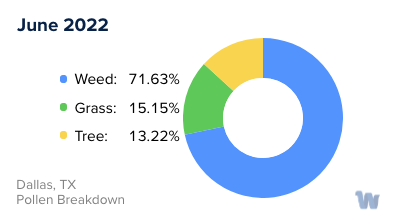
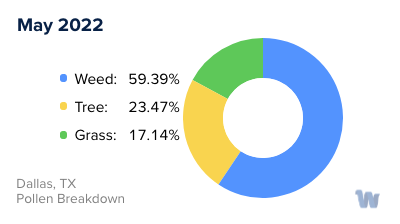
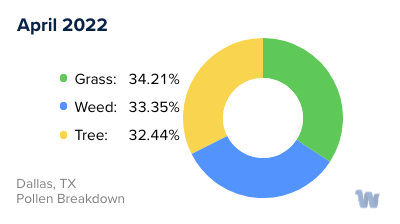
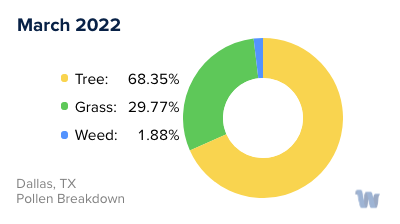
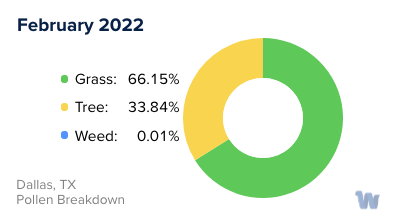
Pollen and Hay Fever in Dallas, TX
Pollen allergies, commonly known as hay fever, affect a significant portion of the population in Dallas, Texas. As an individual's immune system overreacts to certain types of pollen, it triggers a range of uncomfortable symptoms. Understanding the types of pollen and the seasons they thrive in can help residents of Dallas navigate their allergy triggers more effectively.
Dallas experiences a diverse range of pollen types throughout the year, making it crucial for allergy sufferers to stay informed. In the spring, tree pollen is the primary culprit. Oak, cedar, and pine trees are abundant in the region, releasing copious amounts of pollen into the air. This can trigger allergic reactions in susceptible individuals, leading to symptoms such as sneezing, itchy and watery eyes, nasal congestion, and fatigue.
As spring transitions into summer, grass pollen becomes a prominent trigger for allergies. Common grasses like Bermuda grass, ryegrass, and Timothy grass release pollen particles that can cause allergic reactions in susceptible individuals. These reactions may manifest as persistent sneezing, nasal congestion, itchy throat, and coughing.
Late summer and fall bring about a rise in weed pollen allergies. Ragweed is particularly prevalent in Dallas during this time, and its pollen can be highly allergenic. Other weed pollens, such as pigweed and sagebrush, can also trigger symptoms in sensitive individuals. Allergy sufferers may experience symptoms like nasal congestion, itchy and watery eyes, sneezing fits, and fatigue during this season.
While the severity and duration of pollen allergies vary from person to person, many individuals in Dallas find their symptoms exacerbated during windy days when pollen is more easily dispersed in the air. It is advisable for allergy sufferers to monitor local pollen forecasts and limit outdoor activities on high-pollen days to minimize exposure.
By being aware of the types of pollen prevalent in Dallas and the seasons they thrive in, individuals can better manage their allergies and make informed decisions to alleviate symptoms. It is recommended to consult with a healthcare professional for a comprehensive understanding of pollen allergies and appropriate treatment options.

